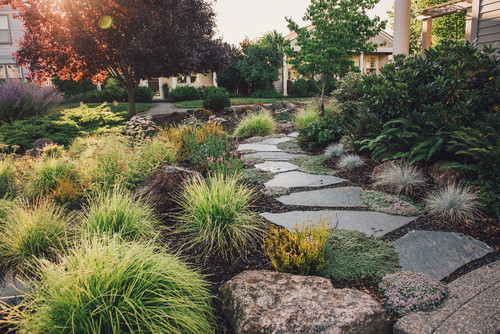What Is Mulch? A Homeowner’s Guide to Groundcover

Singkham/iStock
Those enormous bags lining the aisles aren’t just tripping hazards—they’re also well-calibrated mixtures designed to protect and enrich your plants and and boost your curb appeal with minimal effort. Here’s the lowdown on all things mulch, including types of mulch, how much mulch you need, and more.
Get ready to pamper your plantings!
What is it made of?
Photo by Huettl Landscape Architecture
“At its most basic level, mulch is a spreadable way to cover soil around shrubs and flower beds,” says Sam Souhrada, maintenance division manager at FormLA Landscaping. Among the many types are wood chips and shredded bark (cedar, redwood, pine, juniper, spruce, yew), grass clippings, composted manure, rocks, pebbles, nut hulls—and even sea shells or newspaper.
The mulch materials you need also depend on the zone you live in, notes Craig Jenkins-Sutton, president and co-founder of Topiarius. “In Chicago, which is Zone 6, hardwood works well, including alder, balsa, beech, hickory, oak, teak, or walnut,” he says.
What does mulch do?
Photo by Johnson Creek Landscaping
Mulch is a protective layer that helps the skin of the earth retain moisture and helps avoid cracking, says Souhrada. “It serves as insulation, discourages weeds, keeps roots at a more consistent temperature, and it nourishes the soil as it decomposes, reviving richness and fertility,” he adds. Landscape fabric, a textile made from organic or synthetic materials, can be used beneath any type of mulch to further inhibit weed growth.
Mulch can also prevent critters from digging into your dirt, and it keeps dust from swirling along garden pathways. “And from a design perspective, mulch gives your landscape a finished look and may even serve as an important landscaping element in your gardens,” Souhrada adds.
What type of mulch should I get?
The kind of mulch you buy depends on where you plan to spread it and the look you want. Pebbles and smooth river stones tend to line walkways and prevent soil erosion, while straw is commonly used around vegetable plants. If you want to recycle, try some newspapers. Place a layer in your garden and cut holes in it for each plant or spread shredded papers around bushes.
Wood chips and bark are the most commonly used and widely available type of mulch. “I like certified organic redwood, cedar, or pine bark,” says Souhrada. Shredded wood mulch lasts one to three years and gives a natural look, while rubber mulch won’t decompose, is weather-resistant and can last up to 10 years, reports Rhianna Miller of Rubbermulch.
Size should also be considered with some plantings. Some mulch may be too large, including bark nuggets, which can overwhelm delicate annuals like tulips, but it’s fine around trees. Pathways, slopes, and areas prone to flooding or winds should use heavier, larger pieces.
If bugs are an issue, Matt Michaels, a planting expert from Lowe’s, suggests, “Termites can be attracted to the wood in compost, but more often, they like the larger pieces of wood rather than finely shredded mulch or bark nuggets.” Pro tip: Mulches made from cypress and eucalyptus aren’t as popular with pesky mites; nor are shredded rubber mulch, stone, and crushed rock.
Want some free mulch? “Fallen tree leaves can nourish both the tree and its understory plants, and grass clippings spread over a lawn can protect its moisture content,” says Souhrada.
How much mulch do I need?
Photo by Regenesis Ecological Design
Souhrada recommends a layer about a couple inches thick, spread around with a rake twice a year, in the fall and spring. If you can only manage once, aim for spring. Using groundcover at the start of the growing season maintains soil moisture, protects roots from high heat, and tamps down weed growth.
Too much mulch, however, can suffocate plants—and mulching too early will actually slow the soil’s warming process. “Don’t apply new mulch on top of old—it’ll cause nutrient starvation and plant death,” adds Miller. And don’t cover root bases, as a lack of ventilation prevents the tree trunk from drying, turning it spongy and rotten.
Furthermore, don’t bother spreading mulch on hillsides; the mulch will end up running off in the rain. And avoid blanketing mulch right up to the sides of your home. Instead, leave at least a 6-inch clear area to prevent infestation and allow for drainage.
The post What Is Mulch? A Homeowner’s Guide to Groundcover appeared first on Real Estate News & Insights | realtor.com®.





